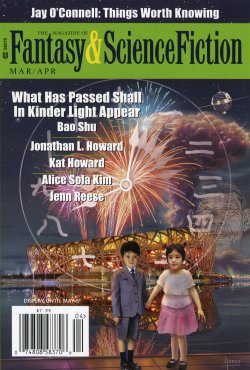

|
| Buy F&SF • Read F&SF • Contact F&SF • Advertise In F&SF • Blog • Forum |
 March/April 2015 |
Curiosities The Refugee Centaur, by Antoniorrobles (1952) LIKE a conflation of Voltaire and Thorne Smith, this lively, witty, whimsical yet sardonic novel by the Spanish writer Antoniorrobles (Antonio J. Robles Soler, born 1895, died 1983) is the mythic yet earthy biography of Auro, a centaur born in the year 1930 in the Spanish village of Villacolorín. Taken by a passing German savant to Berlin, our involuntarily expatriated hero is motivated to reclaim his Iberian heritage and become a writer by meeting a visiting author—one Antoniorrobles! Falling in love with a beautiful exchange student, Encarnita Banzo, provides a spur to action also. Setting out to cross the continent by hoof, Auro first visits the strange Ruritanian land of Pitolia, which proves to be a dangerous outpost of Moonmen. Escaping to Marseilles (en route, women of every social stratum seem inordinately fascinated by his equine portions), he eventually reaches Spain, and of course finds it no paradise, but a prejudiced place not inclined to accept chimeras into polite society. Living in a monastery, swept up in the Spanish Civil War, exiled to Africa, Auro ends up reuniting with Encarnita in Mexico (after visiting a mid-Atlantic realm of mermaids en route, and echoing Antoniorrobles's own migrations), but only tragedy awaits. "Don Quixote and Rocinante in one," Auro maintains his purity for Encarnita until a temptation no male could resist. Eight voluptuous harem women have their way with him. "They kissed Auro's lips raw, they patted and rubbed his horse's buttocks…and finally they forced the centaur off his feet." Whoa, Nellie!
| |
|
| ||
To contact us, send an email to Fantasy & Science Fiction.
Copyright © 1998–2020 Fantasy & Science Fiction All Rights Reserved Worldwide
If you find any errors, typos or anything else worth mentioning,
please send it to sitemaster@fandsf.com.